Agricultural microbiology is a branch of microbiology which deals with the study of microorganisms that are involved in various agricultural processes taking place in soil, plants and agro industries. Agriculturally important processes like the Biological nitrogen fixation, nutrient cycling of Carbon, Sulphur, Phosphorus
After studying this chapter the student will be able,
• To understand the various biogeo chemical cycle
• To know the nitrogen fixation process
• To infer about the biofertilizer
• To learn the role of biopesticides in agriculture
Chapter 11 Agricultural Microbiology Chapter Outline
11.1 Biogeochemical Cycles
11.2 Biofertilizers
11.3 Biopesticides
Learning Objectives
rel a s of (a
and Nitrogen are microbe mediated and play a very significant role in replenishing the nutrient supply in soil. Certain microorganisms like bacteria, fungi and viruses are economically important since they cause plant diseases and are responsible for severe crop losses. The study that deals with plant diseases is called plant pathology.
There are microorganisms capable of producing plant hormones thereby enhancing the plant growth. Some micro organisms can be used as biopesticides as they have ability to kill insects that damage plants.
Biogeochemical Cycles
Biogeochemical cycling is defined as the movement and conversions of materials by biochemical activities throughout air, water and soil. All living organisms participate in biogeochemical cycling but
The Anabaena azollae-Azolla association is a symbiotic ationship between a blue green alga and a rice plant. Azolla is mall, fast growing floating water fern. In the cavities leaves of azolla, Anabaena azollae a blue green algae cyanobacterium) fixes nitrogen from the air.
microorganisms play a major role. This is because of their high enzymatic activity and their ubiquity.
Most macro elemental components of living organisms like Carbon, Nitrogen, Sulphur, Oxygen, Phosphorus and Hydrogen are cycled most intensely and other elements like Copper, Chromium, Iron, Zinc, Nickel are cycled less intensely.
Carbon Cycle
Carbon is a macro element present in all living cells. In microorganisms, they are present in all macromolecules like cell wall, cytoplasmic membrane, proteins and nucleic acids.
Reservoirs of Carbon: Reservoirs are the storage places of nutrients that are present in nature. They store nutrients in large amounts for longer periods of time.
Photosynthesis removes CO2 from the
environment
Respiration
CO2 in th dissolved particula
Organic co in cons
Feeding Death
Organic c in dead o
Organic compounds in green plants
Death
Respiration returns CO2 to the atmosphere

Atmospheric CO2, dissolved carbon in oceans and freshwater, organic matter are actively cycled carbon reservoirs. Sediments and fossil fuels like coal, petroleum and natural gas are slowly cycled carbon reservoirs. Carbon is cycled between these reservoirs by the biochemical activities of micro organisms and other living things (Figure 11.1).
The different stages or processes involved in carbon cycle are
1. Photosynthesis 2. Decomposition 3. Methanogenesis
1. Photosynthesis It is a process where atmospheric CO2 is converted to organic carbon (CH2O)n. This is carried out by higher plants, photosynthetic bacteria, cyanobacteria and algae using radiant energy from
Respiration
Burning
e air and in water,
rly oceans
Organic compounds in fossil fuels
Decay and cecompositicn- CO2 released as microbes
respire
mpounds umers
ompounds rganisms
m of Carbon cycle is as follows
the sun. This can be explained by the equation,
CO2 + H2O (CH2O)n + O2
where (CH2O)n represents the organic form of carbon (Example: Carbohydrates) which gets incorporated into the photosynthetic organisms. This organic carbon serves as food for herbivores and in turn for carnivores.
2. Decomposition The organic matter fixed as a result of photosynthesis is eventually degraded by microorganisms to CO2 during processes like respiration and decomposition. When aerobic and anaerobic organisms respire, CO2 is released into the atmosphere. Much of the CO2 is released when dead organisms decompose in the soil predominantly by the activities of soil microorganisms. Burning of fossil fuels also release CO2
into the atmosphere.
3. Methanogenesis It is an anaerobic process where CO2 gets converted to CH4 (methane) by strict anaerobes like methanogens (Example: Methanobacterium). Methanogens are a group of Archaebacteria found in anaerobic environments like swamps, marshes, rumen of ruminants, paddy fields and gut of termites.
H2 + HCO3 - + H+ CH4 + 3H2O
Methane is converted back to carbondioxide by a process called Methylotrophy.
Nitrogen Cycle
The element Nitrogen (N) is a key constituent in microbial cell. Nitrogen
is needed for the formation of proteins, amino acids, nucleotides and is present in a number of oxidation states inside the cell. Nitrogen is cycled between atmosphere, organic compounds in living things, soil and sediments.
The processes that are involved in Nitrogen cycle are
1. Nitrogen fixation 2. Nitrification 3. Ammonification 4. Denitrification
Nitrogen fixation Nitrogen is present as N2 (N N) in air (78% N2). The triple bonded state of nitrogen makes it very stable and nitrogen in its gaseous state cannot be assimilated by plants or animals for their metabolism. Only few groups of prokaryotes are
Fistulated cow: Fistulated cows are very useful in studying rumen microorganisms and ruminant nutrition and are used to treat indigestion in cows. Fistula is a sampling port that allows access to the rumen. Rumen is the first and the largest chamber of the stomach of cows and other ruminant animals.
Infobits
capable of breaking the triple bond and use it for building up their proteins and aminoacids. The process of reduction of gaseous nitrogen (N2) to ammonia (NH4) is called Nitrogen fixation. This process is carried out by a group of prokaryotes called diazotrophs.
N2+8H 2 NH3 + H2
Cyanobacteria, Rhizobium and Frankia are some of the examples of diazotrophs that can fix atmospheric nitrogen. The fixed ammonia gets incorporated into proteins and amino acids, thus building up organic nitrogen.
assimilation NH4 Proteins, amino acids
Ammonification
Decom (aerobic an
bacteria a
Nitrogen in atmo
Ammonium (
Nitrogen-fixing soil bacteria
Nitrogen-fixing bacteria in root
nodules of legumes
Pla
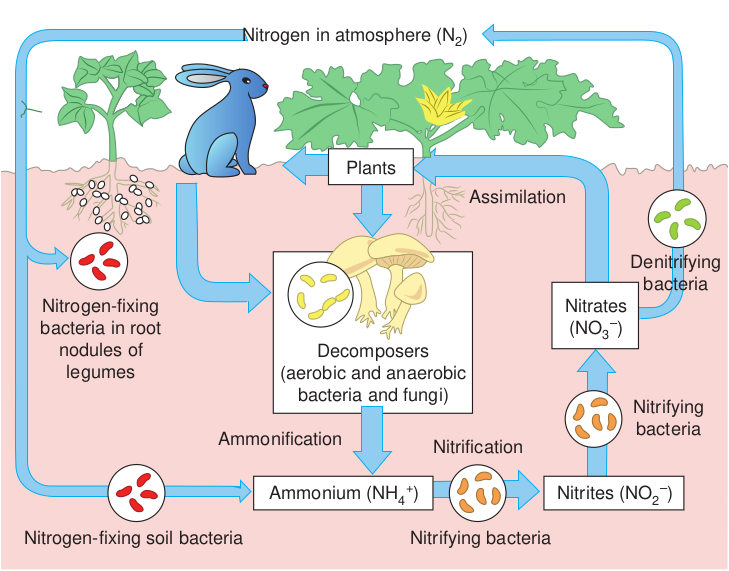
Ammonification The production of ammonia during the decomposition of organic nitrogen compounds, by micro organisms after the death of plants and animals is called ammonification (Figure 11.2). Much of the ammonia released by aerobic decomposition in soil is taken up rapidly by plants and micro organisms and is converted to amino acids.
Bacteria like Bacillus, Clostridium, Pseudomonas and fungi like Aspergillus, Mucor and Penicillium are few examples of micro organisms that can ammonify.
Nitrification The oxidation of ammonia (NH3) to nitrate (NO3) is called nitrification. It is carried
Nitrification
posers d anaerobic nd fungi)
Nitrifying bacteria
sphere (N2)
NH4 +) Nitrites (NO2
–)
Nitrates (NO3
–)
Denitrifying bacteria
Assimilation
nts
Nitrifying bacteria
iagram of nitrogen cycle
|——|——|
out by nitrifying bacteria. It is a two step process where ammonia is first converted to nitrite (NO2) and then to nitrate (NO3).
2NH3 + 3O2 2HNO2 + 2H2O
The above given oxidation reaction is the first step that produces nitrite. This reaction provides energy and is carried out by Nitrosomonas and Nitrosococcus.
In the second step, the nitrite is oxidized to nitrate
2HNO2 + O2 HNO3
This reaction is carried out by Nitrobacter.
Nitrates are readily assimilated by plants but are very water soluble and rapidly leached from soil.
Denitrification The reduction of NO3
- from soils by denitrifying bacteria to gaseous nitrogen is called denitrification. In this process, carried out by bacteria like Pseudomonas, Thiobacillus denitrificans, organic compounds serve as hydrogen donors and nitrates serve as electron acceptor.
NO3 NO2 N2O N2
Biological Nitrogen Fixation One of the most significant biological process taking places on the Earth is biological nitrogen fixation (BNF). This fixation of atmospheric nitrogen carried out by few prokaryotes is cost efficient because industrial production of ammonia by Haber’s Bosch process is very expensive.
Organisms carry out BNF in a free living state in soil or they can establish
symbiotic association with other plants or micro organisms and fix N2. Organisms capable of BNF are
Free living Aerobic Azotobacter
Cyanobacteria
Anaerobic Clostridium Symbiotic Rhizobium
Frankia.
BNF by Rhizobium in leguminous plants Leguminous plants belong to the family Leguminaceae and bear seeds in pods. Example: Black gram, Green peas, Soyabean, Subabul. The bacteria belonging to the genus Rhizobium which can exist in free living state in soil but can enter into symbiosis with legume plants and carry out nitrogen fixation.
Process of BNF It consists of the following steps
1. Infection of legume roots by Rhizobium 2. Formation of root nodules 3. Reduction of N N to NH4 in root
nodules
1. Infection of legume roots by Rhizobium Rhizobium recognises and attaches to the root hairs of legume plant. It invades the root hairs and secretion of certain nod factors result in root hair curling typically called Shepherd’s crook symptom which leads to the formation of infection thread. Infection thread is a cellulosic tube like structure through which Rhizobium moves into the cortex from root hairs.
2. Formation of root nodules The invaded plant cells are stimulated to divide repeatedly thus forming a mass
| Fre e liv in g | |
|---|---|
| Aer obic | Az otobac te rCya nob ac ter i a |
| Anaer obic | C lostr idium |
| Sy mbio t ic | R hi z obiumFrankia . |
of tissue on the roots which are called root nodules (Figure 11.3). Root nodules are fleshy light pink colored globose structures seen on the roots. The bacteria inside the root nodules transform into swollen, mishappened forms. These are called bacteroids. The bacteroids are capable of nitrogen fixation (Figure 11.4)
3. Reduction of N N to ammonia in root nodules This biochemical process is catalysed by an enzyme called Nitrogenase present in bacteroids and happens under diminished O2 levels. The O2 levels in the nodules are controlled by an oxygen binding protein called leghemoglobin. This is a red, iron containing protein which can keep the nodule environment free of oxygen.
Nitrogenase The enzyme nitrogenase is a complex enzyme consisting of 2 enzymes, dinitrogenase reductase and dinitrogenase. Electrons from organic compounds like pyruvate are passed on to dinitrogenase reductase first and then to dinitrogenase which in turn passes them to N N thus reducing it to NH4. This reduction needs 16 ATP, ferredoxin and cytochromes.
N2 + 8e - + 8H
+ 2NH3 + H2
N N + 4H HN=NH + 2H H2N-NH2 + 2H 2NH3
Will nitrogen fixation occur in the presence of air? What will be the fate of nitrogenase enzyme in aerobic condition?
HOTS

Phosphorus Cycle
The element phosphorus (P) is an essential macro element in all living organisms. They are found in nucleic acids and phosphate esters. It is an essential component of ATP and other high energy phosphates and phospholipids.
Reservoirs of Phosphorus 1. Phosphate rock like apatite, a large
inert reservoir 2. Marine and aquatic sediments 3. Dissolved phosphates in soils and
waters 4. Organic phosphates in dead and living
organisms.
Phosphorous transformations mostly happen as inter conversion of inorganic to organic phosphate and insoluble form to soluble phosphates.
Phosphate solubilizations Most of phosphates occur in combination with Calcium, Iron, Magnesium and Aluminium (inorganic P) and thus are insoluble and unavailable to plants and micro organisms. Some micro organisms solubilize those insoluble phosphates by producing organic acids. Example: Thiobacillus, Bacillus thus enabling the plants to utilize it.
Phosphate assimilation Plants and micro organisms can readily assimilate soluble forms of inorganic phosphates like H2PO4
-, HPO4 -2 and HPO4
-3
and incorporate them as organic forms of phosphates like ATP, nucleic acids.
Root cap
Root haoir
Cortical c
Bactero
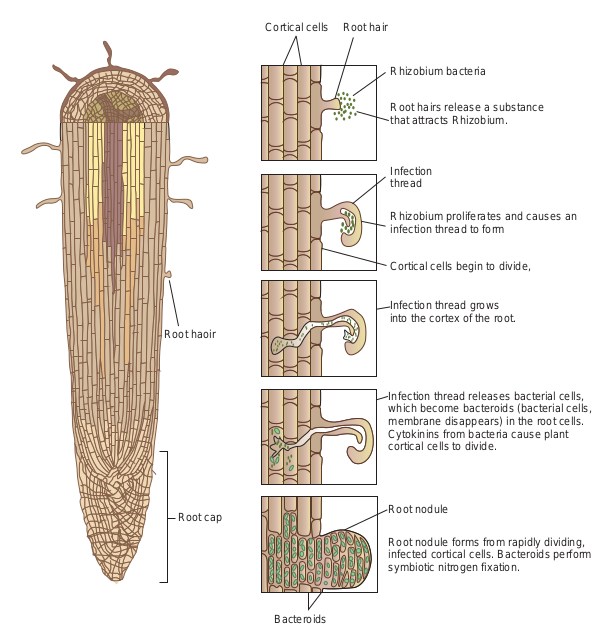
Root hairells
Rhizobium bacteria
Root hairs release a substance that attracts Rhizobium.
Infection thread
Rhizobium proliferates and causes an infection thread to form
Cortical cells begin to divide,
Infection thread grows into the cortex of the root.
Infection thread releases bacterial cells, which become bacteroids (bacterial cells, membrane disappears) in the root cells. Cytokinins from bacteria cause plant cortical cells to divide.
Root nodule
Root nodule forms from rapidly dividing, infected cortical cells. Bacteroids perform symbiotic nitrogen fixation.
ids
tion of root nodules on legume plant
The ability of bacteria to solubilise phosphates can be tested in the laboratory by streaking the bacterial culture in Pikovaskaya agar which contains tricalcium phosphate. Positive cultures show clear halo around growth.
Infobits
Phosphate mineralisation Breakdown of organic phosphates to form soluble inorganic phosphates is called mineralisation. Organisms produce phosphatase enzymes and catalyse mineralisation. The mineralised phosphates can be utilized by plants (Figure 11.5).
Phytic acid Inositol Phytase
Sulphur Cycle
Sulphur is present in sulphur containing aminoacids. The sulphur cycle involves oxidation – reduction reaction between Sulphate (SO4), Elemental S and H2S and hence there is change in the valence states of sulphur from -2 to +6.
The basic steps involved in sulphur cycle are
1. Sulphide/ sulphur oxidation
2. Sulphate reduction
Ph
Runoff
Weathering of rock
Uplifting of rock
Phosphates in solution
Precipitated (solid) phosphates
Rock
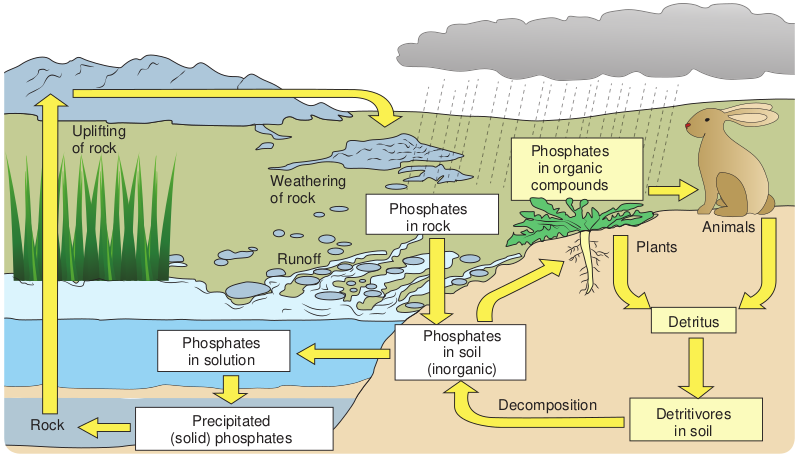
3. Sulphur reduction
4. Organic sulphur compound oxidation or reduction
5. Desulfurylation
Sulphide/Sulphur oxidation (H2S S0 SO4
2-) It is carried out by prokaryotes under aerobic and anaerobic conditions. Under aerobic conditions, H2S is spontaneously oxidized at neutral pH to elemental sulphur. Elemental sulphur is oxidized to suphates by chemolithotrophic bacteria like Thiobacillus, Beggiatoa.
If light is available, H2S can be used as electron donor to carry out photosynthesis
If there is no biogeochemical cycle in the ecosystem, What will happen to the earth?
HOTS
osphates in rock
Plants Animals
Detritus
Detritivores in soil
Decomposition
Phosphates in soil
(inorganic)
Phosphates in organic
compounds
osphorus cycle
under anoxic conditions by phototrophic sulphur bacteria like Chromatium and Chlorobium.
Sulphate reduction When sulphate is present in habitats, different groups of microorganisms are capable of carrying out sulphate reduction.
Beijerinck described the use of sulphate (SO4
2-) as a terminal electron acceptor during anaerobic respiration to form sulphide (H2S). This process is called Dissimilatory Sulphate Reduction(DSR). The anerobic bacteria capable of carrying out DSR are Desulfovibrio, Desulfococcus, Desulfotomaculum (Figure 11.6) This reaction by sulphate reducers requires organic carbon sources like pyruvate or lactate. H2S accumulated in such habitats by the action of sulphate reducers is toxic to aerobic organisms.
The reduction of sulphate to H2S, for building up aminoacids and proteins
Mic oxid
Element
SH sulfh group prote
Assimilation by plants and
bacteria
Burning of fossil fuels
Purple and green phototrophic bacteria
Anaerobic confditions (mostly soil and sediments)
S0
H2SO3
SO2
SO4 2–
Acid deposition
Aerobic conditions Beggiatoa, Thiobacillus
Reduction by
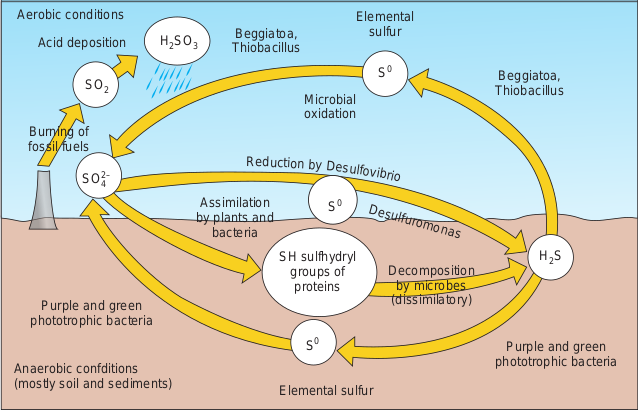
is called as assimilatory sulphate reduction. The H2S thus produced is immediately incorporated into organic compounds.
Sulphur reduction (S0H2S):
The dissimilative sulphur reducing bacteria can reduce elemental sulphur to hydrogen sulphide. Example: Desulfuromonas, an obligate anaerobe. Under aerobic conditions, organisms like Pseudomonas, Proteus and Salmonella are also capable of performing this reaction.
Organic sulphur compounds reduction/oxidation Organic sulphur compounds like dimethyl sulphide can be used as carbon and energy source for many microorganisms.
Desulfurylation It is a process where organic sulphur compounds are used up by microorganisms for energy to produce H2S.
Elemental sulfur
robial ation
al sulfur
ydryl s of ins
Decomposition by microbes
(dissimilatory)
Desulfuromonas
Purple and green phototrophic bacteria
S0
S0
H2S
Beggiatoa, Thiobacillus
Desulfovibrio
ulphur cycle
Biofertilizers
In India, the availability and affordability of fossil fuel based chemical fertilizers at the farm level have been ensured only through imports and subsidies. Indiscriminate and imbalanced use of chemical fertilizers, especially urea, along with chemical pesticides and unavailability of organic manures has led to considerable reduction in soil health. Biofertilizers can act as a renewable supplement to chemical fertilizers and organic manures. They have the capacity to produce natural resistance in plants against pests and soil borne diseases, adding fertility to soil.
Nitrogen fixation by leguminous and other crops is reported to be 44 million metric tons per annum. The appropriate strain of Rhizobium can increase the crop yield up to 10-35%. Also, residual N is beneficial for the next crops grown in the same field.
It has been estimated that 40-250 kg N / hectare(ha) / year is fixed by different legume crops by the microbial activities of Rhizobium.
Definition Biofertilizers are preparations containing beneficial micro organisms like N2 fixers, PO4 solubilizers in a viable static state intended for seed or soil application and designed to improve soil fertility.
Advantages 1. They reduce the need for chemical
fertilizers. 2. They provide the plant with certain
vitamins, plant growth promoting substances and increase the vigour of the plant.
3. It is cheap and cost effective.
Based on the nutrients that they provide, biofertilizers are of the following types
Nitrogenous biofertilizers- • Rhizobium, • Azotobacter, • Azospirillum • Frankia
Phosphate solubilisers • Bacillus • VAM
Rhizobium
Rhizobium – legume symbiosis is a well studied plant microbe interaction and Rhizobium is the most extensively used nitrogenous biofertilizer in India.
Rhizobium is a gram negative, non-spore forming aerobic bacillus inhabiting the soil in a free living state. The colonies of Rhizobium on YEMA (Yeast Extract Mannitol Agar) plate are gummy, pale white in colour (Figure 11.7). They can establish symbiotic relationship with leguminous plants and fix atmospheric nitrogen thereby greatly improving soil fertility.
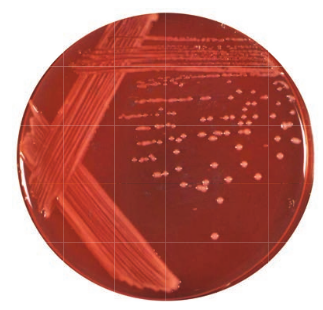
Agar plate
Mass production of Rhizobium The flowchart explaining the mass production of Rhizobium biofertilizer is given below
Efficient N2 fixing strain of Rhizobium are selected and initially grown in YEM
broth for 24 hours.
Inoculum level is increased from 250 ml to 1000 ml in large flasks
Cultures are then grown in large fermentor for large scale production
Broth is blended with powdered carrier material (peat or lignite)
Packing in polythene bags 200g per bag
Curing at 25°C
Dispatch to farmers
Vesicle
Intracellular hyphae
Appressorium at entry point
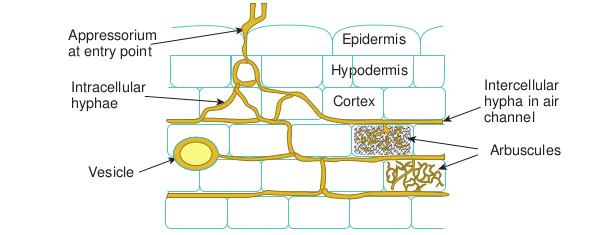
Method of application of Rhizobium to plants Carrier based Rhizobium inoculants are mixed with water to form slurry to which the seeds of plants are added (Figure 11.8). The coated seeds are dried in shade and used for sowing.
Phosphate Solubilizers
Several soil bacteria like Pseudomonas and Bacillus possess the ability to convert insoluble mineral phosphates into soluble form by secreting organic acids thereby making it available to plants.
For mass cultivation and inoculant preparation, the cultures are grown in Pikovaskaya broth for 7-18 days and mixed in suitable carrier like peat or lignite. After curing for a week, the inoculants are packed and made ready for use in a similar manner as Rhizobium inoculants.
3 VAM
Mycorrhiza means fungus root. It describes the symbiotic association between plant and fungus. Vesicular Arbuscular Mycorrhiza (VAM) is an endomycorrhiza which is used as a fungal biofertilizer. They mobilize the soluble
Epidermis
Hypodermis
Cortex
Arbuscules
Intercellular hypha in air channel
of VAM fungi in root cells of plants
|——|——|——|
phosphates in the root zone of plants and satisfy the phosphorus nutrition of plants.
Morphology VAM is an example of endomycorrhiza meaning, the storage organelles of phosphates like vesicles and arbuscles are seen intracellularly. Vesicle is a globose structure and arbuscle is a tree like branching structure present in the root cortical cells (Figure 11.9). VAM fungi are naturally most prevalent in angiosperms. gymnosperms, pteridophytes and bryophytes.
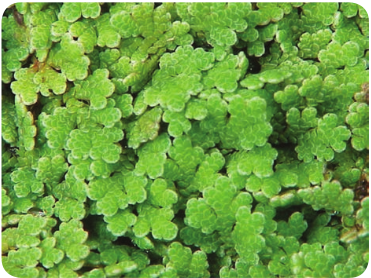
Mass production Root based inoculum is used for preparing VAM biofertilizer (Figure 11.10). The selected spores of VAM fungi are allowed to infect plants like onion, sorghum and other grasses. After 3-4 months, the roots along with the soil are macerated or pelleted with an inert material and packed in polythene pouches which can be used as biofertilizer.
Cyanobacteria / Blue green Algae
Blue green algae are single celled or filamentous prokaryote capable of nitrogen
fixation and photosynthesis. Most of the filamentous forms have specialized large, thick walled cells called heterocysts which are sites of nitrogen fixation.
Example: Nostoc, Anabaena is examples for filamentous BGA. Gleocapsa is an example of unicellular BGA. Some of the filamentous forms do not possess heterocysts but still fix atmospheric nitrogen. Since they need standing water for their growth, BGA can effectively colonize paddy fields and enrich the soil with nitrogen.
Mass cultivation of BGA Applying BGA to paddy fields can reduce the amount of chemical nitrogenous fertilizer applied for the growth of paddy crop. Therefore cultivation of BGA in large quantities is necessary. Mass cultivation of BGA has the following steps.
1. Isolation of BGA 2. Mass cultivation of BGA
Isolation of BGA BGA can be isolated from soil or paddy fields. Appropriate dilutions from serially diluted algal sample are inoculated in the liquid flasks containing algal media
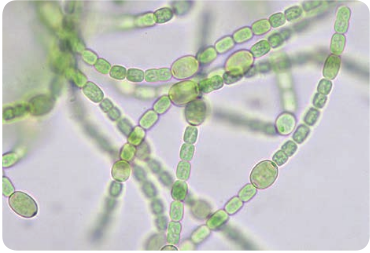
like BG-11 or Pringsheim’s media. After several weeks of incubation at 28°C, the individual colonies are picked up, identified and stored. This can be used as starter culture for mass cultivation. Mass culture can be done in 2 ways.
Mass cultivation of BGA 1. Open air shallow culture:
Pits are prepared (6΄ × 3΄ × 9΄)
Filled with soil and 200g of superphosphate and water is added
Starter culture is sprinkled over water
1 week
Algal scum is formed on the surface
Water is allowed to dry and the dried up algal flakes are collected and stored
in poly bags
The dried algal flakes around 10kg/ha can be applied in paddy fields after transplantation.
Azolla
Azolla is a floating freshwater fern. The plant has a branched stem, deeply bilobed leaves which are arranged alternately on the stem and each leaf has a dorsal and ventral lobe (Figure 11.9). The dorsal lobe houses the cyanobacterial symbiont
Anabaena azollae (Figure 11.10). The fern and the cyanobacteria exhibit symbiotic relationship in which Anabaena provides the fern with fixed nitrogen and fern provides niche for the cyanobacteria free from competition from other microorganisms.
Azolla can be used as a nitrogenous biofertilizer for paddy crop. When applied into the paddy fields, Azolla provides nitrogen nutrition to standing rice crop and can reduce the need for synthetic fertilizers.
Mycorrhiza and orchid germination In the early stages of their life cycle, all terrestrial orchids are non photosynthetic, totally lacking chlorophyll and relying on carbon(C) acquired from a fungal symbiont (Mycorrhiza) for growth until the production of the first green leaves above the ground, a nutritional strategy termed mycoheterotrophy. Around 200 species of orchids remain achlorophyllous throughout their lifetimes. Species such as Galeola, Gastrodia, Corallorhiza, Rhizanthella and many others continue to gain carbon from mycorrhizal fungi.
Infobits
Mass multiplication of Azolla
Small plots (50-100 sq.m) or concrete tanks with standing water are
inoculated with Azolla
pH is adjusted to 8.0 with lime.
Superphosphate is applied as a nutrient and carbofuran is applied to deter insects
After 20 days, Azolla biomass can be harvested and used as biofertilizer for
rice plantings
Method of application of Azolla in rice fields Azolla is grown on the flooded rice fields prior to planting for 2-3weeks. Then water is drained and Azolla is incorporated into the soil followed by rice transplantation within a week’s time.
Why bio- fertilizer are preferred to chemical fertilizer?
HOTS
Biopesticides
Pests are insects that damage crop plants and stored products. They feed on leaves and roots or suck the sap of the plants causing severe crop losses. Chemical pesticides sprayed on plants can be
detrimental to ecosystem if the usage is prolonged and pests may develop resistance to the pesticides.
The term biopesticides refers to compounds that are used to manage agricultural pests by means of specific biological effects. It refers to products containing biocontrol agents like natural substances such as plants, certain minerals, animals, micro organisms including their genes or metabolites.
They are an important part of Integrated Pest Management (IPM) strategy in controlling the pest.
Advantages They are less toxic to humans and environment and they do not leave harmful residues.
They affect only the target pest. They cause long term suppression of
pest populations since they persist in the environment.
Microbial biopesticides are of three kinds
1. Bacterial biopesticide 2. Fungal biopesticide 3. Viral biopesticide
Bacterial Biopesticide
Bacteria like Bacillus thuringiensis, Bacillus papillae and Bacillus lentimorbus have the potential to kill certain insect pests and are entomopathogenic.
Bacillus thuringiensis It is a gram positive, spore forming, rod shaped soil bacterium. During sporulation, the bacterium produces insecticidal proteins as parasporal crystals. These are called delta endotoxin also called as Cry proteins. Cry proteins are specifically
toxic to insects belonging to Lepidoptera, Coleoptera and other few insect orders.
Mode of action of Bt The Bt cells sprayed on the leaves have to be ingested by the larval forms of the insects in order to exert its action. This is because the Bt toxin gets activated in the insect gut at a specific pH.
Process
Insect ingests the parasporal crystals containing Cry protein
The crystals dissolve in the alkaline environment of the insect gut
The solubilised inactive delta endotoxin are cleaved rendering them active
The activated toxin binds to specific receptor of the midgut epithelium
This leads to the insertion of toxin thereby developing pores in the epithelium
Cell lysis and disruption of epithelium releases the cell contents leading to insect death.
Symptoms • Larvae stops feeding • Larvae becomes sluggish and static • Water oozes out from the body • Larvae dies and falls off the leaf
Various species of Bt are able to work against cotton boll worm, cabbage worm and gypsy moths.
Photograph of a cotton plant showing opened and unopened bolls. BT cotton is a genetically modified cotton plant (GM crop) which has the gene for the crystal toxin integrated in its genome. Crystal toxin is expressed in plant parts which reduce the need for spraying pesticides. BT cotton is the only GM crop approved for commercial cultivation in India.
Infobits
Fungal Biopesticides
These entomopathogenic fungi attack insects and cause diseases in insect body which lead to insect death. Two prominent fungi used as mycopesticide are • Beauveria bassiana which causes white
muscardine disease • Metarhizium anisopliae which causes
green muscardine disease
Mode of action of Beauveria bassiana Beauveria bassiana, a filamentous fungus belongs to class Deuteromycetes also called imperfect fungi. It can be successfully used against Colarado potato beetle, (Figure 11.11) Codling moth and American boll worm.
This fungus invades the haemocoel of insects through spores. Once the spores attach to the cuticle, it germinates and the hyphae penetrates the insect cuticle (cuticle is the outer membrane of insects) Penetration is aided by formation of appresorium and penetration peg. The fungi
secrete chitinases, lipases and proteases which can dissolve the cuticle. The hyphae enter the haemolymph and proliferate and colonise the entire insect and release blastospores. Insect death occurs due to nutrient depletion of the haemolymph or by toxaemia by secretion of toxic metabolites.

Biopesticides registered in India: 1_. Bacillus thuringien-_
sis var. israelensis 2. Bacillus thuringiensis var. kurstaki 3. Bacillus thuringiensis var. galleriae 4. Bacillus sphaericus 5. Trichoderma viridae 6. Trichoderma harzianum 7. Pseudomonas fluorescens
Viral Biopesticides
Viral insecticides are pathogens that attack insects and other arthropods. Viral pesticides are used to control Lepidopteran larvae like Helicoverpa, Spodoptera sp on Cotton, Corn, Sorghum, tomatoes. Baculoviruses are the commonly used viral biopesticide. They are extremely small and are composed of double stranded DNA. The genus Baculoviruses contains 3 subgroups.
• Nuclear Polyhedrosis viruses (NPVs) • Granulosis viruses (GVs) • Non occluded viruses
Mode of action of NPV The virus enters the insect body via ingestion by insects and infects the midgut cells by membrane fusion. The NPV uncoat within the nucleus of cells and pass through the intestinal epithelium (Figure 11.12) and establish a systemic infection of the haemocoel.
Symptoms Discoloration (larvae turns brown or yellow) • Decomposition or softening of larvae • Lethargy • Infected larvae hang upside down twigs • Larvae become swollen with fluid
containing virus and eventually die turning black in color.
Mass production of NPV NPV are mass produced in laboratory using suitable larval hosts. The fifth stage larvae are fed with food infected with NPV. After 4-5 days, the dead larvae are collected and macerated. The liquid is centrifuged and the pellet containing the viruses is suspended in sterile distilled water. This viral suspension can be used for spraying in the fields.
1Summary Carbondioxide fixation and Biological Nitrogen Fixation are the most significant biological processes taking place on planet Earth. Methanogenesis is an anaerobic
process converting CO2 to CH 4. It is carried out by methanogens like Methanobacterium sp. Phosphorous transformations mostly happen as inter conversion of inorganic to organic phosphate and insoluble form to soluble phosphates.Purple and green sulphur bacteria store sulphur as granules as a result of which they appear yellow in colour.
Biofertilizers are preparations containing beneficial micro organisms like N2 fixers, PO4 solubilizers in a viable static state intended for seed or soil application and designed to improve soil fertility.
Azolla and Anabaena share symbiotic relationship in which Anabaena provides fixed atmospheric nitrogen to Azolla.
Vesicles and arbuscles in VAM fungi are the storage organelles of polyphosphates.Blue Green algae are prokaryotes that can perform both photosynthesis and nitrogen fixation.
Biopesticides refer to compounds that are used to manage agricultural pests by means of specific biological effects. Bacillus thuringiensis produces crystal toxin which is detrimental to insects.
Evaluation
Multiple choice questions
1. The conversion of atmospheric nitrogen to ammonia by prokaryotes is called a. Biological Nitrogen Fixation b. Nitrification c. Ammonification d. Denitrification
2. The oxidation of sulphide is carried out by a. Thiobacillus b. Purple bacteria c. Beggiatoa d. Both a and b
3. Phosphate solubilisation by bacteria is mediated by the production of a. Organic acids b. Phosphatases c. Phosphoric acid d. Phytases
4. The process of production of CH4
from CO2 is called a. CO2 fixation b. Methylotrophy c. Methanogenesis d. Photosynthesis
5. The reduction of sulphate for building up aminoacids and proteins is called a. Desulfurylation b. Assimilatory sulphate reduction c. Dissimilatory sulphate reduction d. Sulphur reduction
6. An example of nitrogenous biofertilizer a. Bacillus b. Pseudomonas c. Rhizobium
d. VAM 7. The other name for Blue Green Algae is
a. Green algae b. Brown algae c. Cyanobacteria d. Blue algae
8. The selective media for Rhizobium YEMA contains the sugar a. Maltose b. Mannitol c. Glucose d. Lactose
9. Solubilisation of inorganic phosphates by Bacillus is brought about by the a. Production of enzymes b. Production of organic acids c. Production of alkali d. Mineralisation
10. The mass cultivation of VAM is preferably done in a. Sorghum roots b. Rice roots c. Potato roots d. Cotton roots
11. is an example of entomopathogenic fungi a. Verticillium b. Beauveria bassiana c. Metarhizium anisopliae d. All of the above
12. The toxic effect of Bacillus thuringiensis is due to a. Cry protein b. Delta endotoxin c. Parasporal crystals d. All of the above
13. The action by mycopesticide depends on the a. Ingestion of fungi by insects b. Penetration of cuticle by fungi c. Ingestion of leaves infected with
fungi d. Ingestion of spores by fungi.
14. Crown gall is caused by Agrobacterium on a. Monocots b. Dicots only c. Monocots and dicots d. Ferns
15. Smut is a disease caused by a. Puccinia sp b. Ustilago sp c. Verticillium d. None of the above
Answer the following
1. What is the role of purple and green bacteria in sulphur cycle?
2. What is nitrogenase? Give its function. 3. Define biofertilizers. 4. What is VAM? 5. Define biopesticides. 6. What is a smut? 7. What is NPV? 8. List out Bacterial diseases of plants. 9. What is the end result of decompo-
sition of organic matter in carbon cycle? Give the role of microorganisms with examples.
10. What is the function of leghemo-globin? 11. Give the method of application of
Azolla in paddy fields. 12. Give the salient features of
Rhizobium.
13. Explain the mass production of phosphate solubilisers.
14. What is Azolla-Anabaena symbiosis? 15. What is crystal toxin? Write short
notes on BT cotton. 16. Explain the process of root nodule
formation with appropriate diagram. 17. Give in detail the reactions involved in
phosphorus/carbon/sulphur/nitrogen cycle.
18. Explain the mass production of VAM. 19. Give detailed account on Bacillus
thuringiensis.
Student Activity
• Sow two groundnut seeds in a plastic cup/earthern pot. After one month, pull out the plant and observe the root system for nodules.
• Collect pictures of all organisms involved in sulphur cycle and prepare a collage showing its role.
• Prepare a chart work showing the biogeochemical cycles of carbon, nitrogen and phosphorus
• Collect pictures of various diseases of plants and prepare a chart.
• Prepare a model on the mode of action of BT.
• Collect diseased parts of plants and identify the symptoms of the disease.